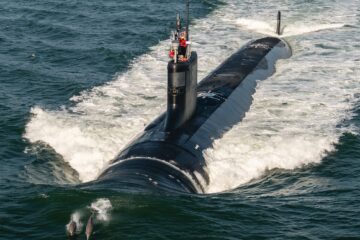Story by TASS Russian news agency
The previous surfacing through the Arctic ice demonstrated Russian Navy capabilities in mid-1990s. The Severstal SSBN of project 941 sailed to the North Pole, surfaced in the ice and test launched a missile.
In March 2021, three nuclear submarines simultaneously surfaced near Alexandra Island of Franz Joseph Land Archipelago. Two of them were Dolphin-class SSBN of project 667BDRM. The third one was the Knyaz Vladimir latest Borey-A-class SSBN of project 955A. The three submarines carried 48 ballistic missiles.
Open sources said each Bulava submarine-launched ballistic missile (SLBM) has six to ten individually targeted reentry vehicles. Sineva SLBM has four to ten vehicles. It makes the total potential number of 480 reentry vehicles. The Independent Military Review estimated the three submarines carried 288 vehicles.

Russian Navy Commander Admiral Nikolai Yevmenov said the Arctic expedition comprised 43 events. It engaged over 600 military and civilian personnel and close to 200 arms and hardware. The expedition proceeded in a harsh weather with average temperature of minus 30 degrees Centigrade, over 1.5-meter thick ice, and wind of 32 m/sec.
He said the event was unprecedented for the Navy. Besides the surfacing of three SSBN, a pair of MiG-31 fighter jets flew over the North Pole and refueled in the air. One submarine fired a torpedo from under the ice. It was later found and extracted through an ice hole. The Arctic motorized rifle brigade held a tactical exercise in bad weather and in unknown terrain away from the main base.
The engaged arms and hardware confirmed the tactical and technical characteristics in high latitudes and low temperatures.
Sailing under the ice is a complicated training element. The ice is thick and sometimes reaches the seabed. It provides the highest secrecy level to submarines. The wake of a submerged submarine can be tracked by satellites, however ice makes it invisible for spacecraft.
The Arctic sorties of Russian SSBN confirmed the highest training level of the crews. The three submarines surfaced in parallel courses in a radius of 300 meters from each other.

Project 667BDRM submarines are third-generation SSBN and will remain the backbone of Russian maritime nuclear deterrence until the fourth-generation SSBN of project 955A with Bulava missiles become operational. The submarines joined the Navy in 1980s. There are six of them at present. The SSBN were upgraded in mid-2000s. The electronic equipment, radars, propeller-rudder system were replaced. The submarines were armed with new Sineva ballistic missiles.
Project 955A SSBN are armed with 16 Bulava SLBM. The Russian Navy currently operates the Yuri Dolgoruky, the Alexander Nevsky, and the Vladimir Monomakh SSBN of project 955 and the Knyaz Vladimir of upgraded project 955A. The Yuri Dolgoruky and the Knyaz Vladimir operate in the Northern fleet, while the Alexander Nevsky and the Vladimir Monomakh in the Pacific fleet.
Sevmash Shipyard is building the Knyaz Oleg, the Generalissimo Suvorov, the Emperor Alexander III, and the Knyaz Pozharsky SSBN of project 955A. Another two submarines are to be laid in 2021.
The US Navy has numerously demonstrated the ability of covert Arctic missions in the framework of ICEX exercise, which also engaged UK submarines and Canadian Air Force.





